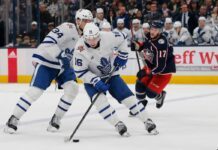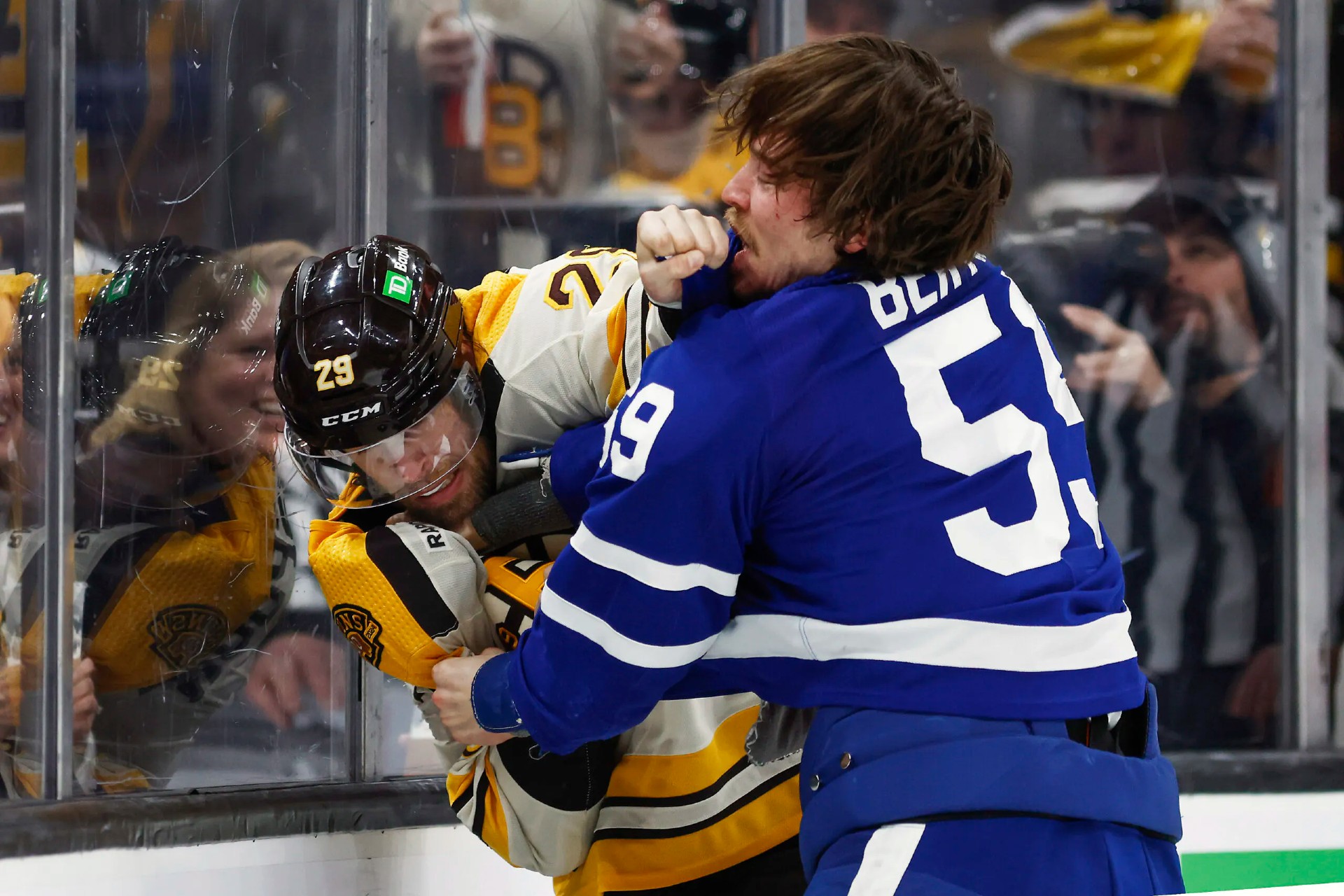Well, here we go again—another year of Leafs playoff hockey and another first-round matchup against the Boston Bruins.
At this point, you have likely heard or read the basic tale of the tape for this series. The Leafs haven’t beaten the Bruins since 1959, losing six straight series to them since then. Toronto went 0-2-2 against Boston this season. The Leafs have suffered Game 7 losses in all three of their series matchups over the past 11 years—all of which were played in Boston—and the Bruins once again own home-ice advantage this spring.
The big difference with the Bruins this time is that their style of play has changed as their roster has seen some key cogs depart. They don’t tilt the ice and wear down the opposition as much, instead relying on high-end goaltending and their counter-attack offensively.
At five-on-five, the Bruins posted the third-best save percentage in the league but were just 24th in shot attempt share. They were opportunistic, recording the fourth-highest shooting percentage in the league. They also finished with the second-highest five-on-five PDO in the league behind only the Canucks. On average, they were outshot 30.5-29.3 per game.
The Leafs finished third in shooting percentage, but the difference is that they were the NHL’s best team at generating offense. They ranked second in the league in basically every major offensive category this season and are a legitimately elite offensive team. Of course, their issues reside on defense and in net.
You could play up or downplay the Leafs’ weaknesses depending on your perspective. If a team is what the numbers say it is when the regular season ends, the Leafs were 21st in goals against per game and 23rd in save percentage at five-on-five. There is no getting around it—those are major red flags.
The numbers also include the first half of the season when Ilya Samsonov really struggled – to put it mildly – en route to a 2023-24 season where finished with a .890 save percentage in 40 games. If we isolate the period after Samsonov returned and regained his form – i.e., January up until last week, before the Leafs clearly shut it down (competitively speaking) ahead of playoffs – Toronto put together a 34-game stretch in which they allowed 2.74 goals per game. That’s tied for seventh with – coincidentally – the Boston Bruins.
Some of it was a regression from the first-half results, but they are probably closer to a league-average team defensively than the porous club from the first half which anchored them to bottom-third-of-the-league results over the season.
It’s a clear-cut case of a strong defensive team with good goaltending, led by one superstar upfront on an otherwise opportunistic offense, against an elite offensive team, led by multiple offensive stars, that has question marks on defense and in net (although the Leafs have flashed signs that they’re better than their defensive/goaltending reputation).
Special teams are a similar story. The Leafs own one of the best power plays in the league but a mediocre penalty kill (which was a respectable 14th since the trade deadline until about a week ago). The Bruins ranked tied for sixth on the penalty kill and 13th on the power play.
In the regular season, the Bruins went 3/10 on the power play against the Leafs and 10/11 on the penalty kill—those numbers would swing a series in which the Leafs should otherwise own a territorial advantage at five-on-five. Toronto did hold a territorial edge in the regular-season series, outshooting Boston 105-91 at five-on-five. But special teams can be the great equalizer.
Line Matchups

The numbers above paint the picture of the teams’ strengths and weaknesses heading into the playoffs, but the playoffs are all about matchups. As such, I will break it down line by line and work through how each team might approach the matchup game. Because of the Leafs’ revolving door of injuries, we have a clearer indication of the Bruins’ Game 1 lines – they practiced with these combinations in their first practice after the regular season ended – so let’s break down those Boston units first.
Heinen – Zacha – Pastrnak
Like the Leafs with the Bertuzzi – Matthews – Domi line, the Bruins put this trio together late in the season – a little over a month ago – and they have been productive ever since. The trio is a bit of a microcosm of Boston’s season, outscoring opponents 17-6 in 186 minutes together at five-on-five but owning 49.72 percent of shot attempts while finishing slightly ahead in terms of expected goals at 52.31 (over 20 percent lower than their actual goal share percentage).
A large part of the line’s bottom-line results is Pastrnak’s sheer brilliance. He scored seven points in four games against the Leafs this season and finished in the top five in league scoring (more points than any Leaf). He was the best player across the four-game season series and a big reason why Boston swept Toronto.
The other part of that equation – and a player who doesn’t receive nearly enough respect – is Zacha. He’s coming off back-to-back 21-goal seasons and recorded a career-high 59 points this season, and he scored four points (three goals) in four games against the Leafs. While Heinen is newer on the line, Pastrnak-Zacha played over 764 minutes together at five-on-five and outscored teams 50-28 in those minutes despite basically drawing even in shot attempts and expected goals. They are scorers and will make the opposition pay if given clean looks, which the Leafs have found out the hard way multiple times.
To counter, Sheldon Keefe will likely look to play the John Tavares – Mitch Marner line against them. The Leafs have used Tavares in this matchup-type role for over a month while spreading their attack across three lines. Marner is their best two-way right winger, and who plays on the line’s left wing will be interesting to watch.
Bobby McMann was in the spot before getting injured, which made a lot of sense – he is big, fast, strong, and responsible defensively. The trio controlled shot attempts (over 58 percent), outscored opponents 3-1, and was ahead in expected goals (over 52 percent), but they barely played together. We also don’t know the health status of Calle Jarnkrok, but he, too, could be a logical fit in a checking-oriented role to round out the line; he’s a sound defensive winger who has played left-wing on a line with Marner before (performing well there), and he has a great shot if the puck lands on his stick for a scoring opportunity.
Now, Jarnkrok’s rustiness and the strength of his hand for shooting or winning battles is anyone’s guess—to say nothing of how McMann’s knee might impact him. Only the Leafs can answer those questions.
The matchup on the blue line is just as interesting. The Bruins paired Lindholm-McAvoy in practice, and McAvoy is the defenseman Pastrnak shared the ice with the most. That’s a fully loaded top five for Boston, but on the flip side, it also exposes them a little bit against Matthews.
The Leafs have been touting defense by committee. Presumably, they will mix and match based on zone starts, whoever is rolling, and the score situation (for example, Timothy Liljegren plays more when the team is losing vs. when they are protecting a lead).
This is a huge matchup in the series. If Pastrnak runs wild offensively, the Leafs will likely be forced to shift Matthews into the matchup against them, and that could possibly mean reuniting Matthews-Marner. If the Tavares-Marner duo can keep them in check, it may force the Bruins to move up Marchand or DeBrusk, putting the rest of their matchups in flux.
Marchand – Coyle – DeBrusk
Charlie Coyle centers the Bruins’ matchup line and has matched up against Matthews in all four games so far this season. The Bruins and Leafs have tied those minutes 2-2. Obviously, similar results in the playoffs would be problematic for the Leafs.
Considering Toronto’s power play has struggled against Boston this season and their penalty kill is a relative weakness, the Leafs can’t afford Matthews sawing off his minutes against Coyle if they expect to win. The Bruins have not played against the newly formed Bertuzzi—Matthews—Domi trio, though, so make of it what you will.
The Coyle line will happily dig in defensively. This trio has been outshot and out-chanced, but they are up 14-9 in actual goals. They will sit back and capitalize on mistakes. Coyle, in particular, is coming off a career-high 26-goal, 60-point season while shooting a career-high 17%. As we work through the Bruins’ lineup, we see a lot of this: players enjoying career seasons/really good years relative to expectations despite not exactly controlling play.
As mentioned, the Bruins’ approach to the matchup game on the blue line will be interesting to monitor. Technically, no Bruins defenseman played more at five-on-five against Matthews this season than Brandon Carlo. The Bruins will have some level of comfort if they choose that route, but part of the story is McAvoy missed a game in the season series; otherwise, it was generally McAvoy drawing the Matthews matchup. Obviously, it would play in the Bruins’ favour if Carlo could match up with Matthews, and the Bruins wouldn’t have to think twice about what to do with McAvoy.
Just as holding court in the Pastrnak matchup against a Tavares shutdown line is a big key for the Bruins, so is this matchup for the Leafs. If the Matthews line doesn’t produce much of anything in this matchup, they will almost certainly have to turn to the Matthews-Marner duo again.
If the Matthews-Marner scenario plays out, how will the chess match shake out between playing them vs. the Coyle line compared to the Pastrnak line? It might then create a further domino effect of reuniting Tavares and Nylander to play against the Coyle line, with Matthews and Marner lining up against the Pastrnak-Zacha line. The matchup game always evolves throughout any series, but the big question is who strikes first and forces the other to adjust.
Lauko – Geekie – Frederic
Will the Bruins keep this line together to start the playoffs? They played under 80 minutes together and owned just 35 percent of the shot attempts, but they have outscored opponents 4-0.
Geekie and Frederic, locked in as a duo all season, owned around 45 percent of shot attempts and have been outscored 17-18 overall at five-on-five. The left wing of this line has been a bit of a revolving-door situation; James Van Riemsdyk has played there quite a bit as well (the line has solid underlying numbers with JVR there, but they have been outscored 7-3).
Working in the the line’s favour is their defensive linemates. Besides Frederic, Geekie has been on the ice the most with Charlie McAvoy and Hampus Lindholm. They still employ Geekie in more defensive roles, but they try to shelter him alongside their top defensemen in matchups against third and fourth lines.
Naturally, this is why the Leafs should spread their attack across three lines. They would be sending Nylander out against this trio and likely forcing the Bruins to ensure one of their better defensemen is on the ice, burning their minutes in the process.
However, can Holmberg produce alongside Nylander? Who will be the other winger? Will Keefe go back to Knies? Will it be Robertson? Again, could Jarnkrok return? Could it be McMann if Jarnkrok moves up into the role?
The questions really fall on the Leafs’ side of the ledger here, but there is a logic to running this balanced look. The Bruins’ third defense pairing is Kevin Shattenkirk on his off side (which is Nylander’s wall) and Andrew Peeke. Nylander would need to eat the matchup alive. We said similar about the Leafs needing to own the Marc Staal minutes against Florida last spring, but they did not accomplish this goal. Furthermore, we can’t say for sure if Nylander will really start on this line.
In fact, if Nylander is on the second line, there is an argument to be made that the Bruins hold the advantage all of a sudden. Frederic produced 40 points this season, while Geekie tallied 39. If JVR plays on the line, he recorded 38 points (12 of which came on the power play). Compare this to the Leafs’ other depth options – Knies finished with 35 points, Robertson with 27 (in 56), McMann with 24 (in 56), Jarnkrok with 21 (in 52), and Holmberg with 17 (in 54). Sure, the Leafs have upside among this group and arguably more talent, but the Bruins have two players who played all season, produced, and are comfortable with each other.
Should the Geekie line prove troublesome, the Leafs are 15 forwards deep and have all sorts of options to try without even touching their top-six forward group. If the Leafs–most likely with Nylander there–can turn the tables on the Bruins’ third line, the Bruins’ already thin depth would really be tested.
JVR – Boqvist – Maroon
This line was a trio for the Bruins in practice on Thursday, but I’m not entirely sure they will remain together. So far this season, they haven’t played a shift together as a line. Boqvist has played the most with Lauko (who could be swapped with JVR) and Justin Brazeau. It’s possible Brazeau is out for the series, so here the Bruins are.
It’s a makeshift unit, but JVR and Maroon need no introduction at this point. They are both veterans and find ways to impact the game. JVR can still produce with some time and space, while Maroon always finds a way to leave a mark on a series.
The makeup of the Leafs’ fourth line as the series wears on is unclear. Kampf and Reaves appear locked in to start, but the other wing is up for debate. It seemed as though the coaching staff was trying Knies alongside the pair, which has some potential as it would add a bit of a gamebreaker to the line in hopes of stealing a goal or two. It’s also worth noting not only the line’s performance with Dewar on it (3-3 in goals, outshot and out-chanced opponents) but Dewar’s contributions as a penalty killer.
Both teams will look for opportunities to sneak their top players on the ice against these lines. Both fourth lines will bring physicality, but they can’t be liabilities.
Special Teams

The Power Play
The Leafs’ power play went 4/39 when Mitch Marner was injured the past month (10.3 percent) and 53/199 otherwise—good enough for 26.6%, which would have ranked third in the league. It is an elite power play and has been for years, but their playoff struggles are well-documented at this point.
We know the personnel on the Leafs’ top unit: Matthews, Marner, Nylander, Tavares, and Rielly. Marner’s motion on the power play is noteworthy. We saw it on his goal against the Panthers this week; he pulled over and found space before one-timing a puck that Tavares deflected in. Without Marner, the top unit became very predictable. Marner adds wrinkles as another right-handed shot who is the true facilitator of the unit.
The Bruins’ top penalty-killers are Carlo on defense and Coyle up front. Lindholm is next on defense, while McAvoy averages 20 seconds less. At forward, the next highest is Marchand. Jake DeBrusk and Pavel Zacha are also primary penalty-killers, so their PK features essentially all of their top players.
The Bruins’ PK is aggressive. Reviewing the tape of their penalty kills against the Leafs, they attacked the wall and took away the primary passing outlets. The Leafs must prioritize attacking down low and connect on a few tic-tac-toe goals to force the Bruins to back off and think twice. Boston will also attack up the ice and disrupt the Leafs’ drop-pass breakout. We will see how the Leafs adjust; they have plenty of tape to review of their power play struggling against the Boston penalty kill.
The Penalty Kill
This battle could single-handedly decide the series. The last time the Leafs met the Bruins in the playoffs, their penalty killed off just 56.3 percent of their penalties (it’s almost impressive that they pushed the series to seven games given this number).
Quietly, though, the Bruins’ power play has been really bad for months. Since the All-Star break, they rank 29th. Pastrnak has one power-play goal in those 33 games (which was, of course, against the Leafs; it came on a 5v3, to be fair).
Pastrnak plays up top with McAvoy, and Marchand usually plays the half-wall. The opposition PKs have aggressively challenged them. Zacha and Coyle generally round out the unit, and while it’s a good collection of players, only one recorded over 70 points. By no means is this an elite group of talent.
The Bruins’ struggling power play could be helped by the Leafs’ ailing penalty kill, though. They struggled throughout the year, and to this day, it’s unclear who will round out their top unit.
Seemingly, Kampf, Marner, and McCabe will be on it. The other most common defenseman, TJ Brodie, might not even make the lineup for Game 1. If Brodie doesn’t play, presumably, Joel Edmundson will occupy the spot. If nothing else, Edmundson is big, takes up a ton of space, and has experience killing big-time penalties.
Holmberg and Nylander have been regulars on the PK for months now. Like Brodie, if Dewar is in the lineup, he will feature on the penalty kill. Jarnkrok is another option if and when he returns, to say nothing of McMann. Like everything else with the Leafs right now, there is seemingly very little locked into place. It’s a very fluid situation. It’s good to have options, but eventually, a decision has to be made.
It’s usually obvious pretty quickly if the Leafs penalty kill will have a good night or not. If they are aggressive and attack with speed, it generally goes well. If they retreat and let the other team’s top players snap the puck around, it usually doesn’t end well.
It should also be noted that the Leafs will need to stay out of the box. Against Florida this week – and in their last game against Boston, in particular – they were charged up and tried to make a point with their physicality. In both examples, it led to many trips to the penalty box, and both opponents capitalized. The Leafs look eager to prove they are not a pushover this season, but it can’t come at the cost of gifting the other team power plays.
Final Notes

– While the Leafs tilted the ice against the Bruins this season, the Bruins were ahead in expected goals by 9.82-7.81 (44.30% for Toronto). This speaks to the Leafs’ inability to get inside on Boston and drive high-danger chances. It is something they’ve struggled with in the playoffs over many excruciating defeats. It’s not due to a lack of scoring talent. They have to get to the inside and stay on the inside.
– GM Brad Treliving flagged secondary scoring as an issue when evaluating past playoff failures. It was a big reason why he signed Bertuzzi and Domi last offseason. The Bruins will want this to be a low-scoring, tight-checking series. The Leafs possess the offensive depth, and if they can break through, it will be really hard for the Bruins to keep up.
– Lots of focus will naturally be on Sheldon Keefe, but Jim Montgomery is 10-10 in his playoff coaching career and faced a lot of scrutiny for his handling of the Bruins’ goalies last spring, the choice not to reunite their “perfect” line enough, and some of his lineup decisions (such as scratching Matt Grzelcyk). The Bruins blew a 3-1 series lead. There is a lot of heat on both teams and head coaches in this series.
– The Leafs will remain tight-lipped about health, and we won’t know much of anything until their playoffs are over. However, a big part of this series already for the Leafs is their injury situations. Is Domi fully healthy? Can Jarnkrok return? What about McMann? These are noteworthy players for their Leafs; they could comprise an entire line in their top nine if they wanted them to. If all of them return and are healthy enough to contribute, the Leafs have an opportunity to overwhelm Boston offensively with their depth. If they aren’t available or fully healthy, it will fall squarely on the Leafs’ big guns. Same as it ever was.
– This is the best time of the year. Enjoy it, everyone! Playoffs are stressful, but it’s okay to have some fun with it, too.

































![Craig Berube Post Game, Blues 5 vs. Leafs 1: “We gave them three goals… The [3-1] goal was lazy hockey” Craig Berube, Toronto Maple Leafs head coach](https://mapleleafshotstove.com/wp-content/uploads/2024/10/berube-craig-lak-pg-100x70.jpg)
